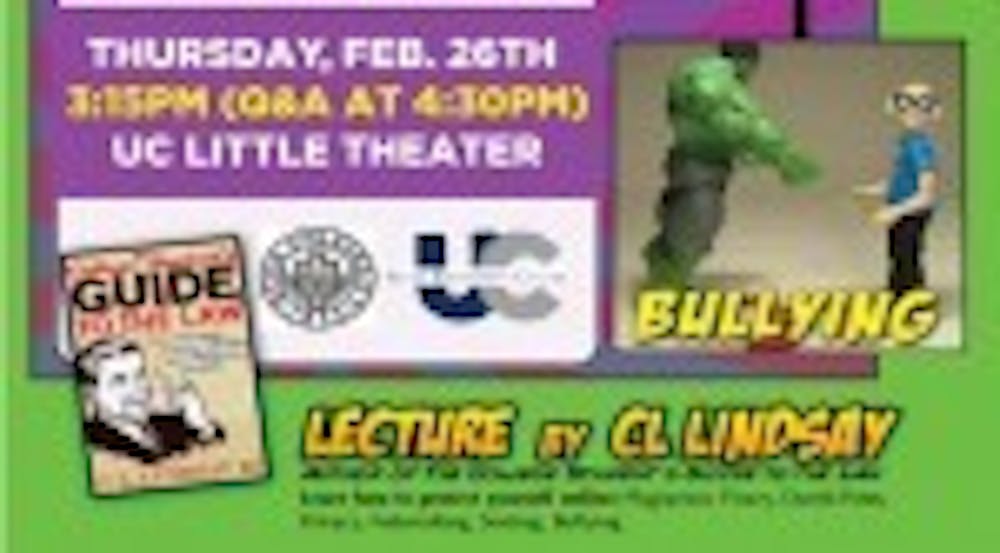On Thursday, February 26, 2015 the organization Campus Life Activities for Student Success [C.L.A.S.S.] hosted a workshop about social media, texting, and the law with the title of Computing The Law. The Little Theatre was nearly filled with students who were waiting to hear what the presenter, author of The College Students’ Guide to Law, and lawyer C.L. Lindsay III, was going to speak about.
Lindsay began his presentation by explaining who he is and students learned that he is not only an author and lawyer, but is also the founder and is currently the executive director of Coalition for Student and Academic Rights, otherwise known as CO-STAR. CO-STAR is a non-profit organization operated by a group of lawyers where students and professors from all colleges and universities located in the United States can call in for help if in any legal trouble. The best part is students and professors can hire one of the lawyers for free. Well, who doesn’t love the word free? And it just so happens that during the “first month it was up online [in the year of 1998],” Lindsay explains, “150 people had called in and requested for help. All of the request were made by students, 149 of the request were related to drinking while one request was about possession of drugs.”
Many students may have heard of the many stories of students getting in trouble with the law due to social media. Some students may not think twice of sending an explicit photo. Well, Lindsay came in to tell the students who had attended that there can be many consequences when a person either sends explicit photos to another via text or through social media.
Lindsay begins the presentation with the quote, “if you are not going to do it offline, don’t do it online.” He continues to explain how an 18 year old boy who lived in a small town in Wisconsin, created a fake Facebook picture using a fake name and a picture of a teenage girl. He started contacting other boys from towns just miles outside of the town he lived in and began to flirt with them. The flirting eventually took a turn when the 18 year old boy began asking for explicit photos of the other boys he was in contact with. Eventually he was caught when he was being investigated in a bomb threat at his high school. He was not charged on any accounts with the bomb threat but was charged of possession of child pornography and multiple other accounts.
“Sending inappropriate pictures of a body part to another person is not illegal,” said Lindsay, “but the laws against child pornography are used against any action of sexting” and as well as any similar cases presented above. Lindsay further explained his quote by saying how a group of teenage boys between the ages of 16 and 17 had received an inappropriate picture of three 14 year old girls. The group of boys was looking at the photo during their lunch break when a teacher confiscated the phone due to the school’s no-phone policy. The teacher saw the photo and took the phone to the principle, in which the principle then decided to call the police and let them handle the case. In the court of law, all of the teenagers included in the case would have gotten at least thirty years of prison. But because of their age, since all of them were below the age of 18, the students received probation for one year, a curfew for one year, and could not have a cellphone for a year.
Lindsay also explained how sending inappropriate text messages to a love one can turn into a case of bullying. He explains how two 18 year olds were dating and the boy in the relationship was going to Florida for a week for a soccer competition. The girl sent an inappropriate picture to her boyfriend, and two weeks later she breaks up with him via text. For revenge of breaking up with him, the boy shared the inappropriate picture with everyone he knew at school and eventually by the following day, everyone at school had seen the picture. From that day on the girl had not received a break from anyone saying inappropriate slurs to her. She eventually took her own life as she could not take any more of the bullying.
Lindsay ended the presentation by showing the audience a clip of photos of teenagers and college students having too much to drink and embarrassing themselves in front of a camera. The overall message of the presentation, and what Lindsay repeats at the end is, “if you are not going to do it offline, don’t do it online.” He also reminded everyone that when using apps like Snapchat that say the picture will disappear, there is always a trace of that picture somewhere in the network and always a way of retrieving that photo. So all in all, think before posting any photos online or sharing them with friends via text message or Snapchat because one click of a button may have many consequences.





